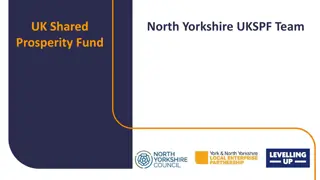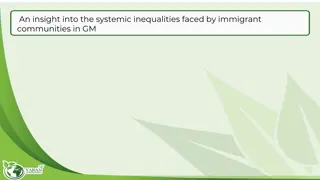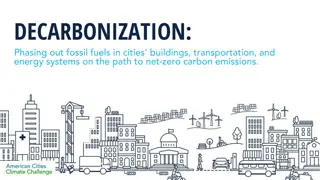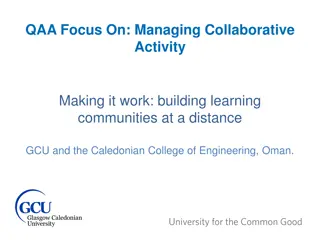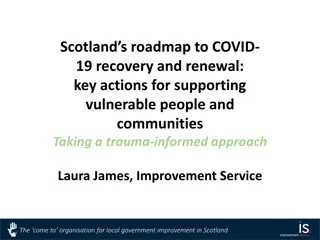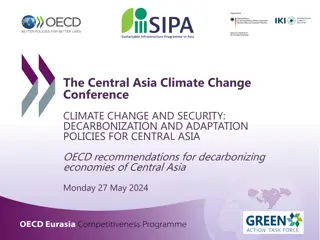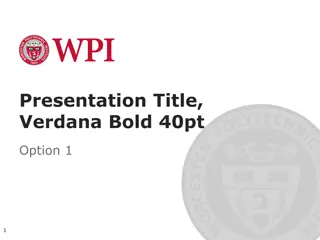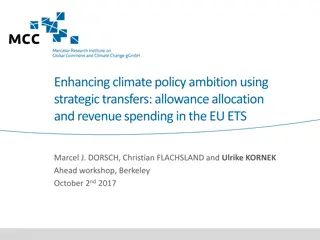Communities Taking Bold Actions for Decarbonization
The report highlights how 1,750 communities globally have adopted Climate Emergency declarations to accelerate progress towards carbon neutrality. It showcases cities like Barcelona, Bristol, and Copenhagen leading the way with innovative strategies to reduce emissions and enhance decarbonization capabilities. The focus is on accelerating carbon reduction targets, expanding local emission solutions, addressing external emissions, utilizing natural carbon drawdown methods, and improving government decarbonization capacities.
Download Presentation

Please find below an Image/Link to download the presentation.
The content on the website is provided AS IS for your information and personal use only. It may not be sold, licensed, or shared on other websites without obtaining consent from the author. Download presentation by click this link. If you encounter any issues during the download, it is possible that the publisher has removed the file from their server.
E N D
Presentation Transcript
THIS IS NOT A DRILL! THIS IS NOT A DRILL! A new CNCA/INC report A new CNCA/INC report Peter Plastrik Innovation Network for Communities February 18, 2021
Gratitude in Solidarity Game Changers: Bold Actions by Cities to Accelerate Progress Toward Carbon Neutrality (2018) This Is Not A Drill: How Communities Are Using the Climate Emergency to Make Big New Moves to Decarbonize Locally (2021) CNCA Framework for Long- Term Deep Carbon Reduction Planning (2015) Publication of Life After Carbon (2019) 2
1,750 communities worldwide adopt CE declarations What difference does this make for GHG reduction? Advocacy for higher level government action Is there more? Why Look at Climate Emergency Declarations? Facing hard truths is how you create transformative change. --Margaret Klein Salamon, founder of Climate Mobilization 3
What We Found: A higher level of ambition & change Barcelona, Spain Bristol, UK Copenhagen, Denmark Glasgow, UK Iowa City, USA London, UK Melbourne, Australia Mornington Peninsula Shire, Australia Oslo, Norway Portland (Oregon), USA San Francisco, USA Stockholm, Sweden Sydney, Australia Toronto, Canada Vancouver, Canada Small % of communities used CE declarations to launch CE planning processes We identified 15 communities (11 CNCA cities) that developed interesting CE action plans Some new ideas/strategies and existing ideas/strategies that have gained new emphasis/traction in communities 4
1) Accelerating carbon-reduction targets 2) Expanding solutions for reducing local emissions 3) Tackling emissions produced outside local boundaries 4) Drawing down carbon through natural means 5) Upgrading local government s decarbonization capacities Five Strategies in the Climate Emergency 5
1) Accelerating carbon- reduction targets Accelerated and/or expanded targets for overall emissions reduction New goal is a 100% reduction to zero emissions or net zero emissions New deadline for most is well ahead of 2050; for some it is 2040, others seek to go faster than that Sydney slashed a decade off the time it would need to achieve net zero GHG emissions, resetting deadline to 2040 Bristol cut a decade, now aims to be carbon neutral by 2030 Also fine-tuned targets for decarbonization of key emissions sectors: energy supply, buildings, transportation, and solid waste 6
As communities reset overall reduction targets, they had to figure out how they would actually reduce more emissions faster than previously anticipated Developed and adopted policies, regulations, investments, and programs to achieve their more aggressive ambitions Buildings: Vancouver will fine targeted building owners whose emissions exceed city-specified levels starting in 2025 a policy that can lead owners to switch from natural gas to electric heating Transportation: San Francisco, seeking to achieve a 25% electric vehicle adoption rate, will accelerate efforts to develop a publicly available electric vehicle charging network, including in off-street parking facilities. Oslo plans to convert all public transport, including busses and ferries, to zero emissions by 2030. Glasgow is rolling out car-free zones at schools and other locations that have large numbers of potentially vulnerable pedestrians, building on a pilot at a school Waste: Mornington Peninsula Shire intends to reduce emissions from landfills by adopting a zero-waste strategy to achieve 100% diversion of materials from landfills by 2030 Energy Supply: Barcelona is easing regulations and increasing financial incentives for property owners to install rooftop solar facilities 2) Expanding solutions to reduce local emissions 7
Addressing Scope 3: imported consumption emissions, embodied emissions, port and airport emissions, food system emissions Iowa City obtained a grant from USDN to inventory the consumption-based emissions that its residents and businesses are generating. (The tool was created by Vancouver.) Toronto is planning to measure, monitor, and reduce consumption-based emissions Portland required the offset of carbon emissions from city- related air travel Oslo requires all new public buildings be built with fossil- free construction machinery and established what is thought to be the world s first zero emission, all-electric jobsite 3) Tackling emissions outside local area 8
IPCC and communities acknowledged that even the best decarbonization efforts are likely to leave some amount of residual emissions between now and 2050 As communities recognize likelihood of residual emissions, they are looking for ways to remove CO2 from the atmosphere, but effectiveness of removal techniques is mostly unproven Composting: San Francisco has been a world leader in producing compost from locally collected organic materials. Nearly 100% of residential and commercial properties in San Francisco are equipped for organics collection service. The city currently generates approximately 187,500 tons of urban green and food waste per year, which when processed yields 70,000 tons of compost Planting Trees & Vegetation: Melbourne, which has planted 22,000 trees since 2012, plans to increase canopy cover to 40% from 22% by 2040. Copenhagen committed to supplementing its ongoing efforts to plant 100,000 trees in the city by purchasing farmland outside of the city and planting a new, semi-urban woodland in cooperation with neighboring cities. Glasgow will build on partnerships within the region to increase tree planting Biochar: Stockholm plans to address projected residual emissions, mostly from plastics in waste incineration, by capturing and storing carbon and increasing biochar production.. City plans to add more biochar plants to its single plant; at full capacity this could sequester more than 25,000 tons of CO2 4) Drawing down using natural means 9
Communities have decided that future city programs and projects must assess their decarbonization impacts. Some have initiated new decision making, monitoring, and accountability structures in government ways to increase their capacity to deliver emissions reductions London works with pension funds and other investors to divest from fossil-fuel businesses and boost investments in energy efficiency, and low- carbon transport and heating. 5) Upgrading local GHG reduction capacities Carbon Budgeting: Barcelona, Bristol, Stockholm, Sydney, and Vancouver are initiating carbon budgets, a tool launched by Oslo in 2017 to boost the effectiveness of local climate action management Procurement: Barcelona, Mornington Peninsula Shire, and Sydney are adding low-carbon and sustainability criteria to their procurement guidelines for the goods and services they purchase and the assets, such as property, that they own Collaborations & Alignment: Melbourne is building a local business coalition to advance efforts to develop circular economies that eliminate waste. Bristol established an Environmental Sustainability Board, co- chaired by the mayor and containing about 15 organizations from inside and outside of city government, to manage its accelerated climate-action approach Funding Community Action: Iowa City sCommunity Climate Action Grants program provides up to $5,000 USD to local community-based organizations for projects that promote or implement one of 35 actions in the city s plan 10
In addition Just Transition: The communities are taking up a cause that just a few years ago only had a few advocates: the need for a just transition to a post-fossil fuel economy Communication: Cities pursuing more aggressive carbon reduction explain that emergency plans are not just about climate change, they re about creating a better city for residents 11
Its about deep local process, not just a better Communities that convert the climate emergency into these strategies for local decarbonization tend to follow a sequence of steps toward that outcome. Declare.Their elected leaders respond to the IPCC guidance and increasing public demands by adopting an emergency declaration often unanimously. Develop. The local government staff takes over developing a menu of action options, often in consultation with community members and advocacy organizations. Decide.Local elected officials and the public receive from city staff a proposed approach or plan for achieving emergency emissions reductions goals. After public deliberations, the council/mayor approve a set of actions for implementation. Disseminate.When local governments communicate with stakeholders and the public about proposed or adopted emergency climate actions, they explain that plans are not just about decarbonization, they re about creating a better city for its residents. plan Focused on 2 very different communities more than 8,000 miles apart: Vancouver, an affluent Canadian city of nearly 640,000 residents, Mornington Peninsula Shire, a popular Australian tourist destination near Melbourne with 164,000 residents living in 44 towns and villages. 12
Conclusion: Beyond Advocacy In their use of the climate-emergency strategies and other approaches, these communities serve as beacons of urban decarbonization that illuminate pathways out of climate disaster and toward a better urban future





